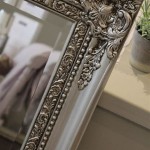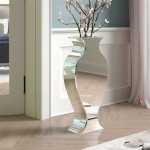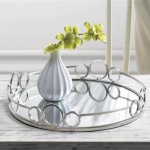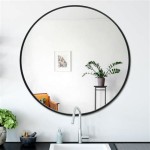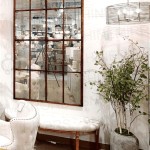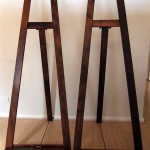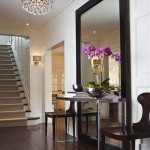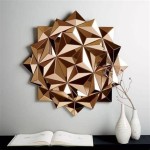Add Frame to Vanity Mirror
A framed vanity mirror can significantly elevate the aesthetic appeal of a bathroom or dressing area. Adding a frame introduces a decorative element that can complement existing décor, enhance the mirror's presence, and create a more polished and finished look. This article explores various methods and materials for adding a frame to a vanity mirror, providing a comprehensive guide for DIY enthusiasts and homeowners.
Before embarking on the framing project, accurate measurements of the mirror are crucial. Using a tape measure, carefully determine the mirror's length and width. These measurements will serve as the foundation for calculating the dimensions of the frame materials. Precise measurements are essential for ensuring a proper fit and a professional-looking result.
A wide array of framing materials are available, catering to different styles and budgets. Wood offers a classic and versatile option, easily customizable with paint, stain, or carving. Its natural warmth can enhance the ambiance of the space. Metal frames, particularly those in chrome or brushed nickel, provide a modern and sleek aesthetic. For a more ornate look, consider decorative molding made from polyurethane or other composite materials. These materials often feature intricate designs and can be painted to match any color scheme.
Adhesive is a popular method for attaching a frame to a vanity mirror. Construction adhesive, specifically formulated for mirrors, provides a strong and durable bond. Liquid nails or mirror mastic are also suitable options. Before applying adhesive, ensure the mirror surface is clean and dry. Apply the adhesive to the back of the frame, following the manufacturer's instructions. Carefully position the frame onto the mirror, ensuring it's aligned correctly. Apply even pressure to the frame to secure the bond and allow the adhesive to dry completely according to the manufacturer's recommendations.
For a more secure attachment, particularly with heavier frames, clips or brackets can be utilized. These provide additional support and prevent the frame from shifting or detaching over time. Specialized mirror clips are available at hardware stores and are designed specifically for this purpose. Position the clips along the perimeter of the frame and secure them to the mirror backing using appropriate screws. Ensure the screws are not too long to avoid damaging the mirror itself.
Creating a frame from scratch offers the advantage of complete customization. For wooden frames, measure and cut the wood pieces to the desired dimensions, ensuring 45-degree angles at the corners for mitered joints. Assemble the frame using wood glue and clamps, allowing the glue to dry thoroughly. Sand the frame smooth and apply a finish, such as paint or stain, to match the desired aesthetic. Attach the frame to the mirror using adhesive or clips as described previously.
Repurposing existing items offers a cost-effective and eco-friendly approach to framing a vanity mirror. Old picture frames, decorative molding, or even reclaimed wood can be adapted to create a unique and personalized frame. Measure the mirror carefully and adjust the repurposed materials accordingly. Apply appropriate finishes and attach the frame using the chosen method.
Safety precautions are paramount when working with mirrors and framing materials. Wear safety glasses to protect eyes from dust and debris during cutting and sanding. Gloves can protect hands from adhesives and sharp edges. Ensure adequate ventilation when working with adhesives or paints. If working with power tools, follow all safety guidelines provided by the manufacturer.
Regular maintenance can prolong the lifespan and appearance of the framed vanity mirror. Dust the frame regularly with a soft cloth. Clean the mirror surface with a glass cleaner specifically designed for mirrors. Avoid using abrasive cleaners that can scratch the mirror or damage the frame finish. Inspect the frame periodically for any signs of damage or loosening and address any issues promptly.
The addition of decorative elements can further enhance the framed vanity mirror. Consider adding small embellishments, such as decorative corner brackets, beads, or even small mosaics. These details can add a personalized touch and complement the overall design. Choose embellishments that harmonize with the frame material and the bathroom's aesthetic.
Lighting also plays a crucial role in showcasing the framed vanity mirror. Install appropriate lighting fixtures around the mirror to provide even illumination. Consider using sconces, overhead lighting, or a combination of both. Proper lighting enhances visibility and contributes to the overall ambiance of the space.
Selecting the appropriate framing style and materials involves considering the existing bathroom décor. For a modern bathroom, a sleek metal frame or a simple wooden frame with a clean finish may be suitable. In a more traditional setting, an ornate frame or a frame with a distressed finish could complement the overall design. Consider the color palette of the bathroom and choose a frame color that harmonizes with the existing elements.

How To Frame Out That Builder Basic Bathroom Mirror For 20 Or Less

Easy Diy Tutorial Adding Trim Around A Giant Mirror For Ers

Diy Bathroom Mirror Frame For Under 10 O Hayley Blog

Diy Stick On Mirror Frame Sawdust Sisters

Mirror Frame Diy How To Update A Basic Bathroom Our Faux Farmhouse

Diy Bathroom Mirror Frame With Molding The Happier Homemaker

How To Frame A Bathroom Mirror

The Kids Bathroom Mirror Gets Framed House Of Hepworths

Diy Bathroom Mirror Frame Without Removing Clips Her Happy Home

How To Frame Out That Builder Basic Bathroom Mirror For 20 Or Less

